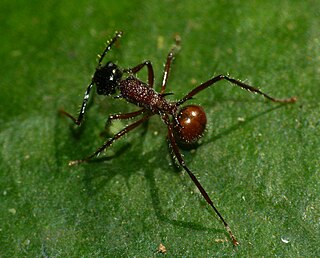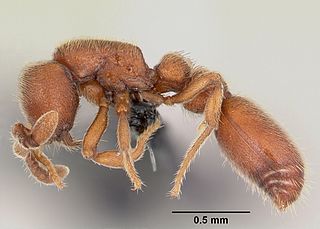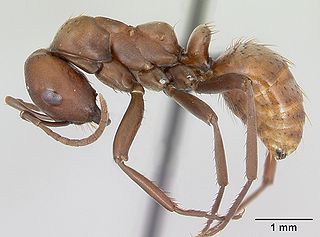
Formica rufibarbis is a European formicine ant of the Formica fusca group. In the classification by Auguste Forel, it is treated in the subgenus Serviformica. F. rufibarbis is subject to a Species Action Plan (SAP) in England, where it is known from only two locations, although it is not considered to be at risk on continental Europe.

Formica is a genus of ants of the family Formicidae, commonly known as wood ants, mound ants, thatching ants, and field ants. Formica is the type genus of the Formicidae, and of the subfamily Formicinae. The type species of genus Formica is the European red wood ant Formica rufa. Ants of this genus tend to be between 4 and 8 mm long.

Formica rufa, also known as the red wood ant, southern wood ant, or horse ant, is a boreal member of the Formica rufa group of ants, and is the type species for that group, being described already by Linneaus in the first version of Systema Naturae from 1758. It is native to Eurasia, with a recorded distribution stretching from the middle of Scandinavia to the northern Iberia and Anatolia, and from Great Britain to Lake Baikal, with unconfirmed reportings of it also to the Russian Far East. There are claims that it can be found in North America, but this is not confirmed in specialised litterature, and no recent publication where North American wood ants are listed mentions it as present, while records from North America are all listed as doubious or unconfirmed in a record compilation. Workers head and thorax are colored red and the abdomen brownish-black, usually with a dorsal dark patches on the head and promensonotum, alghtouh some individuals may be more uniform reddish and even have some red on the part of the gastern facing the body. In order to separate them from closely related species, specimens needs to be inspected under magnification, where difference in hairyness are among the telling characthers, with Formica rufa being more hairy than per example Formica polyctena but less hairy than Formica lugubris. Workers are polymorphic, measuring 4.5–9 mm in length. They have large mandibles, and like many other ant species, they are able to spray formic acid from their abdomens as a defence. Formic acid was first extracted in 1671 by the English naturalist John Ray by distilling a large number of crushed ants of this species. These ants primarily eat honeydew from aphids. Some groups form large networks of connected nests with multiple queen colonies, while others have single-queen colonies.

Formica cunicularia is a species of ant found all over Europe. They are especially common in western Europe and southern England, but they can be found from southern Scandinavia to northern Africa and from Portugal to the Urals. In England, Donisthorpe records the species as having occurred as far north as Bewdley in Worcestershire. In Formica cunicularia, the worker is an ashy grey black color and is usually 4.0–6.5 mm long. The males are found to have a uniformly dark body and are 8.0–9.0 mm long. The queen is yellowish red to dark black and is 7.5–9.0 mm.

An ant colony is a population of a single ant species capable to maintain its complete lifecycle. Ant colonies are eusocial, communal, and efficiently organized and are very much like those found in other social Hymenoptera, though the various groups of these developed sociality independently through convergent evolution. The typical colony consists of one or more egg-laying queens, numerous sterile females and, seasonally, many winged sexual males and females. In order to establish new colonies, ants undertake flights that occur at species-characteristic times of the day. Swarms of the winged sexuals depart the nest in search of other nests. The males die shortly thereafter, along with most of the females. A small percentage of the females survive to initiate new nests.

The name army ant (or legionary ant or marabunta) is applied to over 200 ant species in different lineages. Because of their aggressive predatory foraging groups, known as "raids", a huge number of ants forage simultaneously over a limited area.

Phengaris rebeli, common name mountain Alcon blue, is a species of butterfly in the family Lycaenidae. It was first found and described in Styria, Austria, on Mount Hochschwab around 1700. Although it was initially classified as a subspecies of P. alcon, a European researcher, Lucien A. Berger, designated it as a separate species in 1946. Genetic similarities between P. rebeli and P. alcon have led many researchers to argue that the two are the same species and differences are due to intraspecific variation.

Polyergus breviceps is a species of ant endemic to the United States. It is a social parasite of other ants, namely of Formica gnava but also of Formica occulta and Formica argentea. Polyergus is an inquiline parasite, having lost its ability to take care of its young and themselves. "The workers do not forage for food, feed the young or the queen, or even clean up their own nest". To survive, Polyergus workers raid Formica nests to steal the pupae—which, once hatched, become workers of the mixed nest. This sort of relationship is not unique, of the approximately 8,800 species of ants, at least 200 have evolved some form of symbiotic relationship with one another. What makes Polyergus special is the way a newly mated queen can, all by herself, take over a Formica nest and start a new colony.

Polyergus lucidus is a species of slave-making ant in the subfamily Formicinae endemic to the eastern United States. It is an obligatory social parasite, unable to feed itself or look after its brood and reliant on ants of another species of the genus Formica to undertake these tasks. Parasitic ants are known as "dulotics" and the ants they parasitise are known as "hosts".

Polyergus samurai is a species of slave-making ant in the subfamily Formicinae.

Rossomyrmex is a genus of slave-making ant in the subfamily Formicinae. The genus consists of four species, each with a single host from the genus Proformica, and has a very wide range of distribution from China to southeastern Spain, from huge extended plains to the top of high mountains.

Formica sanguinea, or blood-red ant, is a species of facultative slave-maker ant in the genus Formica characterized by the ability to secrete formic acid. It ranges from Central and Northern Europe through Russia to Japan, China, the Korean Peninsula, Africa and also the United States. This species is coloured red and black with workers up to 7 mm long.

Polyrhachis is a genus of formicine ants found in the Old World with over 600 species. The genus is yet to be comprehensively resolved and contains many varied species including nest-weavers, swimming workers, soil and tree-dwellers.

Ooceraea biroi, the clonal raider ant, is a queenless clonal ant in the genus Ooceraea. Native to the Asian mainland, this species has become invasive on tropical and subtropical islands throughout the world. Unlike most ants, which have reproductive queens and mostly nonreproductive workers, all individuals in a O. biroi colony reproduce clonally via thelytokous parthenogenesis. Like most dorylines, O. biroi are obligate myrmecophages and raid nests of other ant species to feed on the brood.

Slave-making ants are brood parasites that capture broods of other ant species to increase the worker force of their colony. After emerging in the slave-maker nest, slave workers work as if they were in their own colony, while parasite workers only concentrate on replenishing the labor force from neighboring host nests, a process called slave raiding.

Polyergus rufescens is a species of slave-making ant native to southern Europe and parts of Asia, commonly referred to as the European Amazon ant or as the slave-making ant. It is an obligatory social parasite, unable to feed itself or look after the colony and reliant on ants of another species to undertake these tasks. To replenish these servant ants, it raids nearby ant colonies and carries home pupae and larvae, and these are reared to provide future workers for the colony. A newly mated female P. rufescens needs to make its way into one of these "host" nests, kill the host queen, and be accepted by the host workers in her place.

Polyergus mexicanus is a species of slave-making ant in the subfamily Formicinae. It is the most widely distributed species of Polyergus in North America. It is an obligatory social parasite, unable to feed itself or look after the colony and reliant on ants of another species, Formica, to undertake these tasks. The parasitic ants are known as "dulotics" and the ants they parasitise are known as "hosts".

Formica incerta is a species of ant found in eastern North America. It is the most common species of Formica in many areas, and excavates underground nests with small entrance holes. Its diet includes nectar produced by extrafloral nectaries and honeydew, which it obtains from aphids and treehoppers. It is the main host for the slave-making ant Polyergus lucidus. F. incerta was first described by Italian entomologist Carlo Emery in 1893. Its specific name comes from the Latin incertus meaning "uncertain" and seems particularly apt given the subsequent uncertainty as to the validity of the species and the difficulty in distinguishing this ant from other species living in the same area.

Formica pallidefulva is a species of ant found in North America. It is a red to dark brown ant with a shiny body, and varies in shade across its range. Colonies of this ant are found in a variety of habitats, where they excavate underground nests with galleries and chambers. In some parts of its range, the nests may be raided by slave-making ants, most notably Formica pergandei and Polyergus montivagus.

Leptothorax muscorum is a species of ant of the genus Leptothorax that ranges through a variety of habitats throughout much of Europe, northern Asia, and North and Central America, with a particularly wide distribution in the palearctic. Capable of surviving in extreme Arctic-Alpine conditions, the species is perhaps the northernmost dwelling ant indigenous to the Western Hemisphere.






















